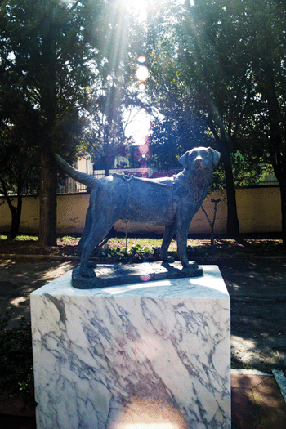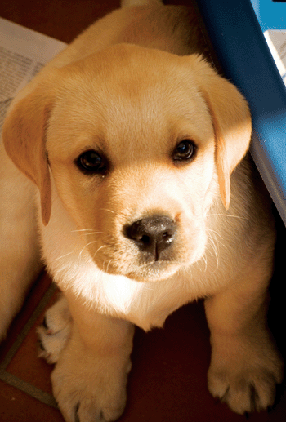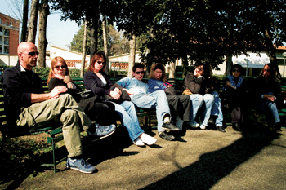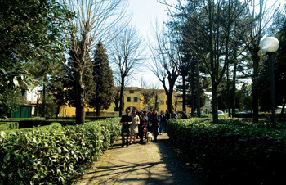There are places where it feels like home. It could
be the story behind those places, the atmosphere, who lives there;
breathing the land's perfumes you can experience intense emotions as
well.
Scandini's National School for Guide Dogs to the Blind is such a
place. Immersed out of time, mysteriously ingrained in our memory, full of
surprise and adventure, it is our destination on this excursion. In the
bus that brings us through the Tuscan-Emilian Apennines, the atmosphere is
already beginning to warm up: Cavazza's young people are singing and
joking, and even Skipper and Viola, the two Labradors, seem to be smiling.
For Viola, it is an important visit: she is born in Scandicci, there she
learned a trade and is going back today not only for a visit, but also for
an examination of her ability.

The school, in fact, always follows up
on you even after you are assigned a dog, and the regular visits are
useful to make sure that your dog can work yet better.
Founded in
1929, the Scandicci School, second in the world, still maintains today its
leadership in efficiency, care and passion. Managed by the Italian Blind
Union until 1975, it is today administered by the Tuscan Region which
follows all stages of dog training until the dogs are allocated all over
Italy, according to a tradition going back a long time ago. A blind person
with a guide dog appears in fact in a graffiti of the Paleolithic era
found inside a cave and in a fresco in a Roman villa in Pompei, preserved
today in Naples' National Museum. Since then, the bond between man and dog
has crossed the history of humanity between the freedom of friendship and
the rigours of discipline, uniting breeds of animals and species of men
all over the world with unaltered passion until today.
It is with this
same passion that Corrado, the trainer accompanying us in our school
visit, tells us what it means to train a dog. For a few years, we have
been working with blood lines, this means with dogs born and selected by
us in collaboration with the University of Pisa. We mainly work with
Labradors, Golden Retrievers and only 10% of German
Shepards.

Although they are great dogs, the
shepards have an irrepressible guarding instinct which can be difficult to
control, while the Labradors and the Golden Retrievers are breeds that are
at ease among people; they never attack, therefore they perform better as
guide dogs.
Watching the Labrador puppies playing in the garden,
chasing each other in a disorderly manner and running towards us as soon
as we come close to them, it seems difficult to imagine that they
conscientiously obey their master's commands. But, Corrado explains to us
that they all respect the rules.
Today, at the end of the training only
8% of the dogs are rejected and that is because each puppy follows a
precise course. From two to five months, a dog assimilates whatever
experience without fear, that is why, when it is two months old, we
entrust it to a family that has the duty to have it live normal
experiences. The traffic, the city, people, that every day life that it
could not learn about in school. The puppy stays with the family during
one year, and once a month it goes back to school to make friends with the
instructors and learn to know the environment. It is all instrumental to
the fact that when it will be two years old, it will live easily with its
new master without having previously gotten attached to someone else. The
difficult work begins after the year it was entrusted to the family. Back
to school, the dogs are trained in whatever situation.
In Florence,
they begin the real dog guide school: subway, sidewalks, steps, narrow
streets, stations, pedestrian walkways, intersections. Every action is
tried, repeated and studied. Each dog learns how to do everything, the
training consists in repeating the exercises and in providing positive
reinforcement.

Like human beings, dogs also
tend to repeat whatever has deserved some gain.
In nature, no animal
will waste energy to carry out activities that are useless and
unfavourable.
The dog is corrected in a decisive manner, but it is not
punished, and at the end of the two years, if it passes the final exam, it
is assigned to someone.
This is the most beautiful day and,
at the same time, the saddest. There are mixed emotions: for us, it
is the last day that we spend with our puppies, but for the new masters,
it is the beginning of a deep friendship. Here at school, we also try to
create the best match, to join together the master and the dog which
correspond the best in terms of technical, character and physical
abilities.
And who does not pass the exam? What happens to rejected
dogs? Corrado smiles.
They are nevertheless dogs full of good
qualities, and we give them to whomever requests one of them, favouring
social cases, disabled people, children with dawn syndrome, because a dog
is always the best social mediator. It stimulates one to get out there, to
make new friends, and it is an endless source of affection, warmth and
comfort.
The school is to become in fact a polyfunctional centre for
disability, where new methods and new teachings are experimented. Dogs can
learn everything, even to turn off lights, and here they are tested to
obey commands given at a distance with a methodology that in America has
given excellent results. Cavazza's young people have thousands of
questions and Corrado responds to each one of them with kindness and
competence, preparing them to welcome their future friend. The school also
has a residence where the master can stay when he is assigned a dog. Even
we, humans, must learn the basic steps to obtain obedience from the dog
and to move about with confidence, and it usually takes a week in school
to learn the basics and to establish a good relationship. From what
Corrado says, it all seems easy and simple. But when we go in the kennel
to take pictures, we find eight uncontrollable puppies. Affectionate and
vivacious, they run towards us and we understand the impressive work that
will transform these Labradors and Golden Retrievers into disciplined and
obedient companions. Incidentally, the bond between man and dog is based
on instinct, heart and teachings, and where ends the school's discipline
begins the unique and precious relationship which unites each dog with its
master.

There begins a world made of caresses, sensitivity and words, where trust is the most important value, and where itineraries in the city intertwine with those of the soul, getting not only the man closer to the animal, but also the man closer to himself. After all, is that not what should be taught in school?